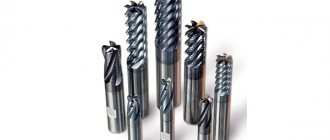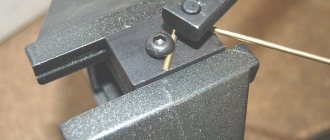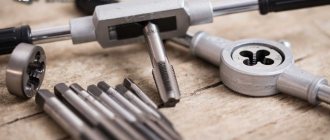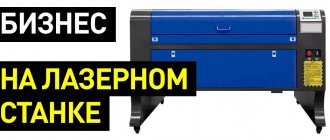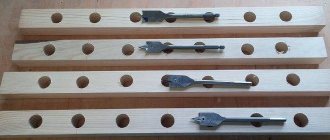Manual wood router for the home workshop
High-quality power tools, which include a hand router, will always be appropriate assistants for home craftsmen. The services of such equipment are used by furniture manufacturers, carpenters and finishing craftsmen.
Thanks to its universal design, a manual milling machine is capable of working not only with wooden blanks, but also with other textures, which include various types of plastics, composite materials, plexiglass or artificial stone. Often, it is possible to form a complex relief, punch through complex grooves, or give a given shape only with the help of an electric hand-held wood router. An ergonomic small device in a home workshop will be more convenient than bulky stationary machines that consume tens of kilowatts and require several square meters of free space.
What types of cutters are there?
It is quite convenient to have a manual router at home, because it can significantly facilitate the performance of some household tasks. But in order to start working on the machine, to do it efficiently, you need to select and then install on it the correct shape, type and size of the cutter. Therefore, next we will talk about how to choose the best cutters for convenience and functionality.
In fact, this is an ordinary nozzle, one side of which is designed to be fixed directly into the cartridge. Its working part is located on the other side; in fact, with its help the material is processed.
Important! In order not to make a mistake, it is recommended to immediately determine for what purposes you generally need the machine. The quality of work directly depends on the type of nozzle.
They are divided into the following types:
- With guide bearing.
- With solid base.
Important! The first option involves the presence of a bearing, which slightly complicates the design. In the second case, the tool has the appearance of a solid, high-strength structure.
The difference between manual models
A manual wood milling machine has many advantages over massive classic machines. For the latter, the principle of operation was to ensure the movement of a workpiece fixed on the frame relative to the rotating edge of the cutting tool. The cutter remains fixed in the spindle. This method has remained effective since the invention of the milling machine in the early 19th century.
Technologies of the second half of the 20th century made it possible to assemble a manual wood router for industrial and household use in small dimensions. The main task of the electrical devices was to ensure rotation of the cutter, and the feed (movement along the workpiece) was done by the operator himself. In some models, the design of the tool is directed not downwards, but upwards. In this case, you have to move the workpiece, rather than the manual router, along the surface.
The tool is capable of working with any materials and performing several operations at once
The tasks performed by the framer are related to the creation of decorative products from relatively soft blanks. The device is suitable for decorating all kinds of partitions, repairing or assembling furniture, or making other massive structures.
At first, young professionals doing DIY repairs may get the impression that this unit has a complex structure. This is not true. The features that distinguish this manual wood cutter are as follows:
- the equipment is fixed directly onto the drive shaft (spindle);
- the design does not contain intermediate units for transmitting rotation, as is the case with other electric tools;
- the power of the power head, which is installed on wood routers, is comparable to similar parameters of stationary equipment;
- a distinctive feature of manual installations is a significantly higher rotation speed than that of conventional machines;
- The mobile device comes with many auxiliary devices and accessories that provide a high degree of processing accuracy, including templates, clamps, stops, etc.
VIDEO: Rules for choosing a hand router for beginners
Design features of products
The main components of a milling machine are the following blocks:
- electric motor;
- sole;
- rod mechanism;
- equipment fastening unit;
- collet chuck for tools.
The sole is made in budget models from stamped sheet metal, and in advanced models from aluminum elements. If you don’t know which option to choose, then give preference to cast soles, characterized by clear geometry and a high-quality fit to the surface being treated.
Unit design and controls
The ability to move the head vertically ensures the functionality of the equipment. It moves along a pair of guide rods. Minimal play, absence of distortions and wobbles are evidence of high-quality equipment.
The equipment is fixed on the spindle in a collet chuck. A specially shaped nut presses the collet, cut into petals, into the conical hole of the chuck, providing a reliable grip on the cylindrical part of the cutter shank. A set of collets allows you to fix all popular tool sizes. Please note that some collets are made according to American standards and their diameter is a multiple of inches, not mm.
Variety of models
Before choosing a manual router, you need to decide what tasks it should perform. Manufacturers offer several types of tools, which can be either specialized (designed for a wide range of tasks) or narrow-profile (performing a limited range of operations).
Rod (submersible) type of equipment
Designed to perform basic operations, which include the formation of grooves, shaped holes, radius surfaces, chamfers, closed contours, etc. Affordable for both home work and small production.
Edge (edging)
Engaged in cutting grooves, chamfering, and forming grooves. It copes well with processing products whose surface is covered with veneer or laminate. It is in demand in industrial conditions, but there is little work for it at home.
Rotary type
Designed for cutting through holes in wood, ceramic products, plasterboard boards, and plastic products. Capable of edge processing.
Lamellar wood milling machine
Produced by manufacturers for precise cutting of grooves used when connecting individual parts. Experts often use this device to remove branches, resin pockets, etc.
Additive for dowels
Refers to highly specialized technology. The choice of a router in this category is relevant for furniture production. It forms paired holes to provide connections in the dowels.
Design features of the main components
The sole of the device is an important structural element that determines the purpose of the tool and the nature of its use. Household and budget models have soles made of stamped metal; more expensive, professional models are equipped with platforms made of aluminum alloys.
The presence of stops and guides simplifies the use of the tool
All additional devices and guide mechanisms are attached to the sole, as well as vertical rods. The working surface of the platform, its lower part, must have a special overlay made of plastic or dense wood. The working stroke of the cutter is determined by the design of the rod mechanism, and it is this indicator that determines the functionality and performance of a tool of this type.
The head part of the device moves along guide rods, and the amount of immersion is adjusted using handles. It can be fixed using a special lever located on one of the handles or with a special screw. Some models are manufactured with a removable head, which allows them to be used as a permanently mounted straight grinder or drill.
Universal milling machine "Bosch" model "GMF 1600 CE L-Boxx" with a removable head
The range of cutters available for use with a specific router model depends on the attachment point of the equipment, because The diameter of the cutter must correspond to the diameter of the collet chuck. If the diameter of the mounting hole of the fastening unit is larger than the diameter of the cutter shank, then you can use special adapter bushings, which can be purchased separately from the cutters if they are not included in the delivery set. The presence of stops and guides allows you to process workpieces with a high degree of accuracy and facilitates the performance of complex and time-consuming operations.
The best routers
Any carpenter or owner interested in the individuality of home furnishings knows that woodworking is impossible without a special tool. The best routers are indispensable for producing straight and shaped grooves, cutting out complex-shaped holes, lamellas and other work on hard materials. The types of manual wood routers differ depending on the desired result: vertical, edge, lamella, filler. Worthy nominees were selected for each category and presented in the ranking.
Device
Plunge milling device
The body is the “head” or “head” of the router; it moves up/down during operation. The guides are rods mounted on the working sole. When you press on the handles, the body moves down; when the pressure on the handles decreases, the springs lift the “head” up.
A wood cutter is attached to the motor spindle with a collet, which cuts into the wood to a set depth. The maximum immersion depth of the cutter is set by a special stop. If, after immersion, you begin to move horizontally, the milling cutter performs a groove.
The milling cutter is also equipped with control buttons - on, off and lock.
Which company's router is better to choose?
In order not to get lost in the variety of assortments, you need to narrow down the options by purpose and manufacturer. You can avoid encountering a low-quality product by choosing a tool from trusted companies that do not stop developing:
- DeW alt is a global company with American origins. Engaged in the production of construction tools and clothing. In 1922, the chief design engineer loudly announced himself by introducing a standard saw that combined quality and durability.
- Black + Decker is an American brand founded back in 1910. Starting from a small workshop, the creators managed to win the trust of customers thanks to high demands on their products. Today, specialization is limited to household, construction, and garden equipment.
- Bosch is a German group of companies that has been developing since 1810. The corporation strives to create idealized products for household use. Starting from car accessories, household appliances, ending with packaging materials.
- Elitech is a trademark owned by . For a long time they acted as distributors on the Russian market. Inspired by the success of international brands, managers decided to create their own production of equipment and home appliances.
- Kolner is a Russian brand that began operating in 2008. It quickly fell in love with customers due to its combination of low price and high quality. Today, management has created positive competition for the world's oldest companies.
- Bort is a Chinese company that has been operating in the international market for more than 22 years. Production is carried out according to German engineering developments. The extended warranty – 24 months – confirms the high interest. The manufacturer often conducts statistical studies. Therefore, it proudly states that the products are often chosen by girls because of their ease of use.
- R Yobi is a Japanese company registered in 1943. With characteristic national pedantry, managers closely monitor production technology, safety and environmental friendliness. At the same time, they do not forget about the needs of the end user.
- Hammer is a German corporation, registered in 1980, but began its production only in 1997. During this time, engineers gained experience by studying the latest technologies. But entry into the market was very competitive. Measuring, gardening and construction equipment pleases customers with European quality.
- Makita is a Japanese manufacturer of electric and gas powered tools. A small workshop for repairing electric motors since 1917, it has become one of the best on the market. Today it produces more than 350 instruments and even more accessories.
- Interskol is a Russian company founded in 1991. It can boast that it has taken a leading position in the international market. Production facilities are constantly expanding without losing quality.
Rating of milling cutters
To decide which router is best to buy for your home or work, you need to carefully consider a number of characteristics that it has. When entering the nominee into the TOP, the opinions of experts, customer reviews, equipment testing results, as well as the following selection criteria were taken into account:
- Stationary/mobile type;
- Use on the machine;
- Rechargeable or wired;
- Cord length;
- Backlight;
- Adapter for connecting a vacuum cleaner;
- Storage case;
- Weight;
- Price;
- Type of work;
- Material compatibility;
- Collet size;
- Immersion depth;
- Power;
- Performance;
- Replaceability of elements.
The best milling cutters included in the 2021 ranking have good performance in all respects, so I deservedly take my place.
Manual wood router: varieties and tips for choosing
A hand router is a special power tool designed for processing wood. Using this device, the master can carry out shaped finishing of edges, cut grooves and drill holes in workpieces.
Currently, there are a large number of different types of manual wood routers, differing from each other in their functionality, technical characteristics and operational capabilities. Before purchasing this or that model, you need to pay attention to the rating of the most reliable and high-quality among them.
Depending on the design features and purpose, manual milling cutters can be divided into several large groups, such as:
- Plunge (vertical or hose) wood routers . Such devices are distinguished by their versatility. With their help you can perform almost all basic milling operations. These include creating grooves and drilling holes. In addition, devices of this type allow for rounding, chamfering, closed contour processing, etc. Submersible devices can be used both at home and in production workshops.
- Edge (or edging) wood routers . As a rule, such devices are purchased for production. In home workshops their use is impractical. Using such devices, you can select grooves, create grooves, chamfer, or cut recesses according to patterns. Edge milling cutters allow for precise processing of parts whose top covering is made of veneer or laminate.
- Rotary wood routers . A distinctive feature of such devices is the ability to drill holes in various materials. These include not only wood, but plasterboard, plastic, and tiles. You can also process edges using a rotary router.
- Lamellar wood routers . Such devices are monofunctional. With their help, you can only select grooves.
- Additive milling cutters for wood . These tools are also highly specialized. They are intended to create paired holes. They are used to connect elements on dowels.
Advantages
Pictured: DeWALT edge router DWE6005.
Lightweight, maneuverable, comfortable.
Edge cutters, also known as edging cutters, have relatively modest power (from 450 to 720 W), but this is precisely what makes them good. Compact dimensions and low weight make the tool maneuverable and very easy to use. The small sole allows you to turn around in confined spaces. The trimmer is guided along the workpiece with one hand. In some cases, this significantly simplifies the work, since it eliminates the need to fix the part on the workbench.
The best wood routers of 2019–2020: rating of manual electric models (top 10)
For processing wooden products and restoring furniture, convenient modern tools have been invented that do not take up much space and greatly simplify the process. A hand router can perform several functions - drill holes, remove chips, make longitudinal and transverse cuts. To get high-quality results, you need to choose the right device.
We decided to review the best wood routers of 2021 and 2020
and rated models based on reliability and functionality.
Pavel Ilyin , a professional carpenter with 10 years of experience,
helped us with this .
There are many models available in tool stores, so deciding which handheld wood router to choose is not always easy.
The top 10 includes high-quality devices from various price categories:
1. BOSCH POF 1200 AE
2. CALIBER FE-1900/12M+ 3. Makita RP2301FCX 4. Makita RT0700C 5. Hammer FRZ710 PREMIUM 6. Interskol FM-40/1000E 7. Makita PJ7000 8. Metabo LF 724 S 9. DeWALT D 26204 K 10. VORTEX FM-1900
The best wood router for home BOSCH POF 1200 AE
- power – 1.2 kW;
- maximum rotation amplitude – from 11,000 to 28,000 rpm;
- milling depth – 55 mm;
- maintaining constant performance under load;
- main shaft fixation system;
- smooth start.
The rating of wood routers for the home is topped by BOSCH POF 1200 AE. This device is distinguished by functionality and power. Thanks to the 1200 W motor, it is capable of cutting wood of any hardness. The speed is stabilized by the Bosch-Electronic system.
Their number is regulated by the accelerator in the range from 11,000 to 28,000 rpm, so the result is accurate and accurate. Since the milling depth is 55 mm, the tool can easily make shaped threads and complex holes (for example, recesses for hinges).
The small unit is suitable for beginners in a home carpentry workshop. Can work with any wood.
Reviews
Owners like that the device is very lightweight and is easy to operate even with one hand. The router is budget-friendly, but the technical characteristics are balanced. The possibility of working with wood of increased hardness is also noted. The downside is that it is impossible to lock the power button, which makes it difficult to work for a long time.
The best budget router for the home workshop CALIBR FE-1900/12M+
- power – 1.9 kW;
- amplitude of rotation of the cutter – from 6000 to 26000 revolutions per minute;
- maximum milling depth – 5 cm;
- operating speed adjustment;
- There is a parallel stop, a copying sleeve.
The top of the best manual milling cutters in the budget category is headed by CALIBR FE-1900/12M+. This device is a vertical type. The tool has a good 1.9 kW electric motor. The speed of the cutting part is from 6000 to 26000 rpm, which is enough to process parts made of any type of wood.
Cutting grooves and ends occurs smoothly, without additional load on the part of the operator - this is possible due to the high level of torque. Compatible with 8 and 12 mm interchangeable accessories.
The disk rotation speed controller helps to more accurately adjust the intensity of the tool. Workpieces up to 5 cm thick can be processed.
The manual wood router for the home workshop CALIBR is suitable for processing small volumes of material.
Reviews
Users speak of the model as a good unit, convenient, affordable, high quality and functional. One of the disadvantages is the presence of play in the cutting equipment, which reduces accuracy.
Pros:
- high-quality assembly;
- cheap;
- stable design;
- ergonomic handles;
- optimal price-quality ratio;
- low noise level;
- soft, flexible power cord;
- There is a tube for connecting a vacuum cleaner.
Minuses:
- there is play in the cutting equipment;
- springs are tight.
Additional equipment for manual milling machines
As a rule, hand-held milling cutters come with various guides and other auxiliary devices, but if they are not enough, you can always purchase them separately or make them yourself.
The presence of additional equipment expands the functionality of the tool
Additional accessories for hand routers include stops and a guide rail, a copy sleeve and an angular stop, as well as a compass ruler. Parallel and horizontal stops allow you to process workpieces at an equal distance from the edge (edge) of these elements, and the guide rail serves for linear movement of the router. The copying sleeve is a round plate, equipped with a side, inserted into the opening of the support platform and providing support around the working cutter. An angular stop is used when making a copy of a finished product, and a compass ruler helps to process workpieces along a certain radius.
The copy bushing for the router is a stamped product
The best professional manual router Makita RP2301FCX
- electric motor power – 2.1 kW;
- maximum rotation speed of the cutter – 22000 rpm;
- milling depth – up to 7 cm;
- 6-step operating mode;
- smooth start and stop;
- illumination of the cutting area.
The Makita RP2301FCX was first in the top of the best professional hand routers. The purpose of this machine is to make grooves and chamfer on wooden workpieces. The electric motor has a power reserve of 2.1 kW. The amplitude of rotation of the cutting equipment can be adjusted using a wheel on the body in the range from 9000 to 22000 rpm.
Thanks to the 12 mm collet format, different cutter sizes can be used. The cutting depth can be adjusted with an accuracy of 0.1 mm, with a maximum value of 7 cm. The cutting area is illuminated by 2 powerful LEDs. The soft start and stop function ensures smooth operation - the workpiece receives minimal damage. The tool is expensive, the cost can reach up to 10,000 rubles.
Makita professional tools are recommended for working with any type of wood due to their high power, functionality and good technical characteristics.
Reviews
According to reviews from professionals, this is a high-quality tool with a good set of functions and balanced technical parameters. It has a good build and high wear resistance. The tool is easy to hold thanks to good ergonomics. The disadvantages include heavy weight and overpriced.
Pros:
- build quality;
- power, performance;
- accuracy;
- ergonomic design;
- easy access to replace brushes;
- reliability and durability.
Minuses:
- heavy;
- there is no dust extraction pipe.
How to choose a router for your home
Choosing a router for home use is not an easy task for beginners. The main criterion is the type and frequency of carpentry work performed. If you need to purchase a universal router, it is better to choose a vertical type, since it can adapt to any type of processing. For work in a small workshop, an additive type of apparatus is more suitable. For furniture restoration, edging tools are most often used, as they are lightweight and convenient.
The service life of the device depends on how correctly the choice is made.
We'll tell you how to choose a manual wood router for your home and what parameters to pay attention to:
- Purpose of the unit
. Milling cutters vary in their area of application; they can be submersible or vertical, edge type (edging), lamella, rotary, and filler. Vertical – the most versatile, suitable for all types of carpentry work. Edge models give the end of the workpiece a shaped profile. Lamellar (they are also called keyed), as a rule, are used for cutting grooves. The main purpose of rotary devices is to drill holes in various materials (from wood to ceramic tiles). - Electric motor power
. A high value always provides the best performance. This manifests itself in the possibility of increasing speed on hard workpieces and deeper processing in one pass. According to this parameter, devices are classified into 3 categories: household (up to 0.75 kW, weight - from 2 to 3 kg), semi-professional (0.75 - 1.5 kW, weight - from 3 to 5 kg), professional (1. 5 – 2.3 kW, weight – from 5 to 6 kg). - Milling depth
. The distance the cutter can plunge into the part. The characteristic is selected individually depending on the expected thickness of the material being processed. - Automatic speed control under load
. When processing a hard workpiece, the speed of the cutting part slows down. This will result in tool jerking and damage to the workpiece. Most milling machines implement a circuit that maintains a given speed under varying loads on the cutting set. - Sole
. This is the lower part of the unit on which the emphasis is made. Made from cast metal or stamped from sheet metal. The first type fits tightly to the surface of the wooden part, allowing you to perform the work better. Stamped structures are much cheaper and are installed on budget milling cutters for domestic use. - Brand
. Users often choose between the two most well-known companies - Makita or Bosch. According to experts, the best manufacturers also include Bort, DeWALT, Elitech, Hitachi, Kolner, RYOBI, Skil, ZUBR, Interskol, Fiolent.
Types of instruments
| Tool name | Technical feature | Note |
| Submersible (equal – vertical, equal – rod) | The peculiarity of the fixation is the location of the power unit, actuator, and control systems on parallel guides. Connection via support platform. Feed vertically downwards towards the workpiece. Return due to springs. Refers to the universal type | Milling of grooves, cutouts, holes; formation of chamfers, corner joints. Closed loop processing. Used by home craftsmen and workshops |
| Rotational view | The body is elongated along the main longitudinal axis. Equipped with a rubber pad for a secure hand grip. Highly specialized species | Formation of blind and through holes. Edge profiling |
| Edging (equals – trimmer, equals – edging) | Working displacement in vertical and horizontal planes. One-handed operation. The body acts as a handle and at the same time includes an electric motor. Universal tool class | Designed for forming chamfers and edges. Cutting a groove, designing a recess for fittings using a template. Grooving, adjusting straight and curved surfaces. Found application in workshops and small production |
| Lamellar appearance | Outwardly it resembles a manual tractor scraper. A special feature is the horizontal position of the cutter that forms the groove for the lamella. Narrow specialization | The main purpose is to develop a groove, performs a trimming function |
| Filler milling cutter | It resembles a lamellar router, but is equipped with two cutters for turning out a seat for dowels. Narrow purpose of the tool | Drilling paired holes. Used to produce furniture |
Selection criteria
The choice of router is determined by the type of operations performed. Qualitative characteristics are the technical parameters of the tool.
| Parameter | Numerical or qualitative indicator | Note |
| Power | Light class, 2~3kg, 420~750W | Determines the duration of continuous work, the size of the cutting tool |
| Medium, up to 5kg, 800~1450 W | ||
| Heavy, from 6kg, 1500~2300 W | ||
| Spindle speed | 10000~35000 rpm | The purity and accuracy of processing depends on the indicator. Selected depending on the type of material being processed and the depth of milling. A useful function that allows you to implement this parameter is the ability to adjust the rotation speed |
| Cutting tool stroke | 20~80mm | Affects performance. But, with increasing performance, power and, accordingly, weight increase |
OPTIONS:
- Smooth start . Provides shock-free contact with the workpiece, increases processing accuracy.
- Overload protection . Protects the router from failure when the engine overheats. The function applies to professional grade.
- RPM support. Allows you to maintain optimal speed values when the external load increases.
- Unintentional start. Protection against accidental start of the router. Controlled by a special locking button.

